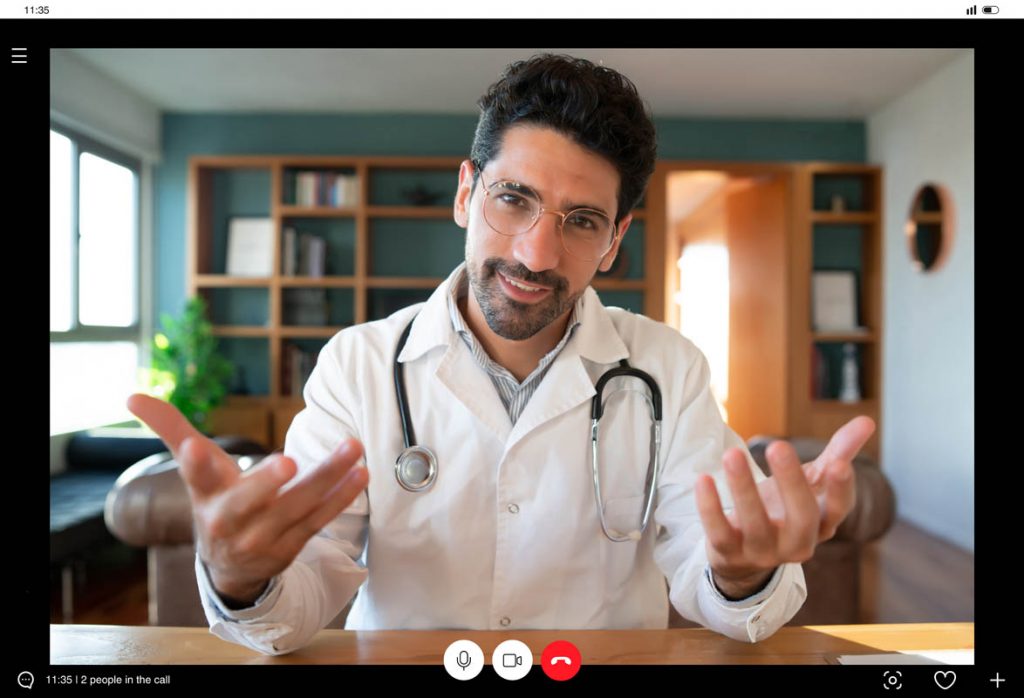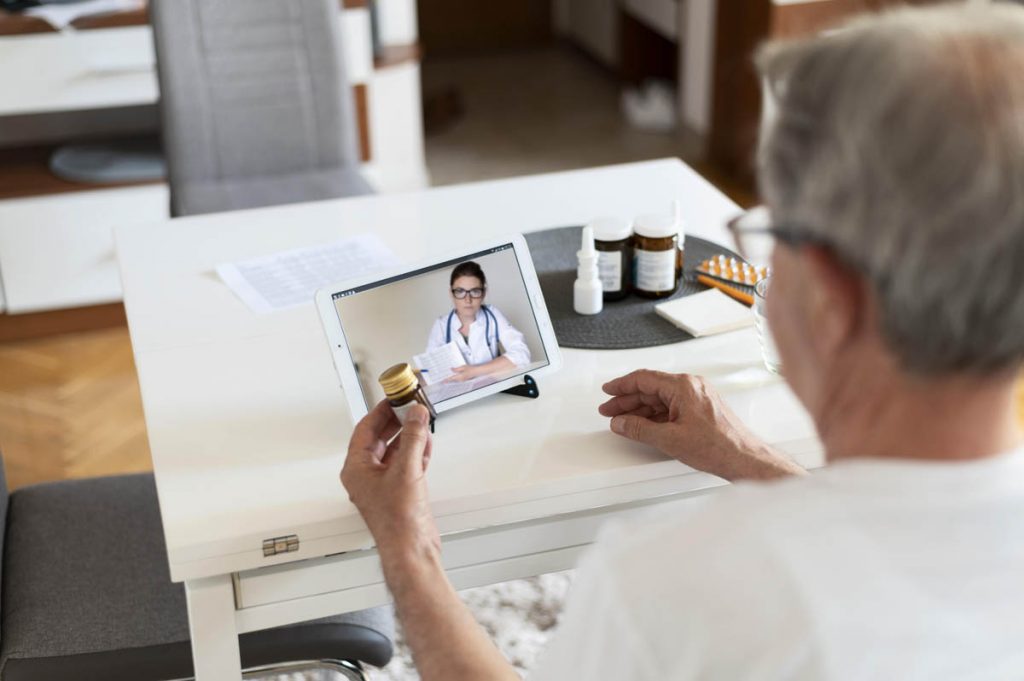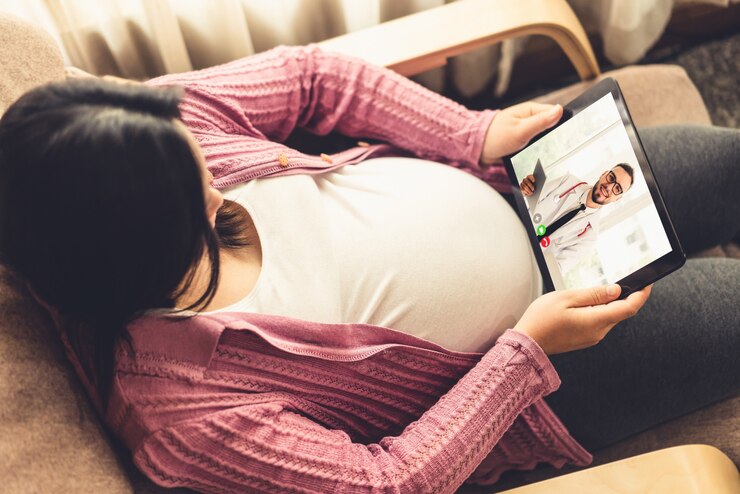
The growth of telemedicine for mental health
October 5, 2021
What is the ideal telemedicine solution for the UAE?
December 8, 2021Remote patient monitoring is one aspect of telehealth with great potential to improve health care provision and outcomes. Technological advances, such as the Internet of Medical Things (IoMT) and 5G networks, are enabling increasing adoption of remote patient monitoring.
What is remote patient monitoring?
Remote patient monitoring (RPM) is a healthcare delivery method that uses technology to monitor patient health outside of a traditional clinical setting. RPM refers to the specific technology used to electronically transmit information between patients and physicians, and it is one delivery system within the broader telemedicine industry that is gaining popularity around the globe.
Why use remote patient monitoring?
As people are living longer with chronic diseases, such as hypertension and diabetes, they require regular monitoring to maintain a good quality of life for as long as possible. Frequent clinic appointments are time-consuming and expensive. Remote patient monitoring can reduce the number of visits, and provide a more complete picture of a patient’s day-to-day health. RPM can also be used post-operatively, reducing the time spent in hospital.

What is remote patient monitoring currently used for?
The uses of RPM are continually expanding, current uses include:
Blood sugar monitoring
Data from fingerstick home testing enables improved diabetes management as the effects of diet and medication can be more closely monitored. Continuous glucose monitoring systems take glucose readings in interstitial fluid that surrounds cells in the body, via a small sensor inserted into the skin of the abdomen, throughout the day. Some systems send blood sugar level alerts or reminders to take medication.
Blood pressure, heart rate and blood oxygen monitoring
Connected digital blood pressure monitors remotely transmit blood pressure and heart rate data. Wearable devices can also track oxygen saturation and heart rate throughout the day, enabling improved management for hypertension, other cardiac conditions, and respiratory diseases.
Electrocardiography (ECG)
Remote electrocardiography monitoring measures the rhythm and electrical activity of the heart via wearable devices. Real-time data from these devices can help detect cardiac conditions such as arrhythmia, myocardial ischemia, and ST depression, enabling earlier interventions when required.
Anticoagulation monitoring
Patients taking anticoagulants require regular blood clotting time (PT/INR) testing and review of medication dosage to balance the risk of either harmful clots or excessive bleeding. Sending data from home anticoagulation testing devices enables better management for anticoagulation therapy.
Weight monitoring
Connected smart weighing scales can help in weight monitoring. They are especially useful for individuals with congestive heart failure, where a sudden weight gain may alert to fluid retention.
Medication monitoring
Smart connected pill dispensers can be used to prompt patients to take the prescribed dose of their medication at the right time of day. Some can also track and report medication intake and order refills.
Medical alert systems
Wearable devices may be used to send an emergency alert in the case of falls, for the elderly and infirm.
Respiratory monitoring
Remote electronic respiratory monitors can be helpful in the management of COPD, asthma and other respiratory diseases.
Home dialysis monitoring
Remote patient monitoring of peritoneal home dialysis is showing promise in reducing hospitalization for kidney dialysis patients.

What are the benefits of remote patient monitoring?
Remote patient monitoring allows providers to stay continuously connected with patients, enabling the following benefits:
- Reduced number of hospitalizations, readmissions, and lengths of stay in hospital
- Faster diagnosis and access to treatment
- Reduce adverse events and medical emergencies
- Fewer in-clinic appointments, saving the associated time and financial costs
- Personalised health information empowering patients in self-management
- Improved compliance and clinical outcomes
- Older or disabled individuals enabled to live in their own homes for longer, avoiding the need to move into skilled nursing facilities
- Reduced risk of viral transmission through physical contact during pandemics
How to effectively use remote patient monitoring?
Information gained through RPM should be used effectively and safely. As with any test or investigation, the data gained is only one part of the overall picture of an individual’s health, and should be assessed together with other signs and patient-reported symptoms. Any telemedicine practice where patient data is shared, including RPM, must comply with local data protection regulations, such as HIPAA and GDPR.
Adoption of RPM requires an alignment of patient and provider needs. Systems should be efficient and easy to use. Training in the correct use of monitoring devices should be provided to patients, relatives or carers, and healthcare staff. Cost considerations include finding out about sources funding for the required equipment and reimbursement through insurers.
Systems which comprehensively integrate data with electronic medical records (EMR) and existing workflows are key to successful RPM programmes which can help clinicians proactively identify care gaps and intervention opportunities.
Remote patient monitoring is most effective when integrated with other telemedicine services, such as teleconsultations or secure direct messaging to provide feedback and advice, with in-clinic appointments available whenever required.
MEDOMENT is an innovative patient engagement solution that seamlessly integrates patient-provider interactions, electronic medical records and health information for improved care experience and outcomes.
RECENT POSTS
- 7 Benefits of Medoment RPM for Your Practice
- Remote Patient Monitoring for Chronic Disease Management
- Can telemedicine help reduce the impact of cardiovascular diseases?
- Can telemedicine be used during pregnancy?
- Can Telemedicine Improve Diabetes Management?
- How to conduct a physical exam via telemedicine
- How can MEDOMENT Optimise Patient Engagement?
- Can patient engagement portals improve healthcare?
- How to choose the right telemedicine software partner
- How to invest in telemedicine software

